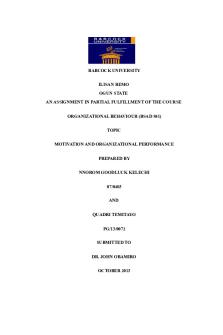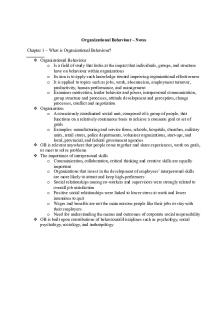Organizational Behaviour Glossary PDF

| Title | Organizational Behaviour Glossary |
|---|---|
| Course | Organizational Behavior |
| Institution | Institute of Business Administration |
| Pages | 17 |
| File Size | 470.9 KB |
| File Type | |
| Total Views | 136 |
Summary
Download Organizational Behaviour Glossary PDF
Description
Chapter 1: What is Organizational Behavior – Glossary Def Definitio initio initions ns Plan Plannin nin ningg Org Organizi anizi anizing ng Lead Leading ing Con Controll troll trolling ing Ma Manage nage nagerr Org Organiz aniz anization ation Tec Technica hnica hnicall Ski Skills lls Hum Human an Skills Con Concept cept ceptual ual Skills Org Organiz aniz anization ation ational al Beh Behavio avio aviorr (OB) Sys Systema tema tematic tic SStudy tudy Evid Evidence ence ence-Bas -Bas -Based ed Ma Manage nage nagemen men mentt (EB (EBM) M) Intu Intuition ition Psy Psycholo cholo chology gy Soci Social al Ps Psycho ycho ychology logy Soci Sociolog olog ologyy Ant Anthrop hrop hropolog olog ologyy Con Continge tinge tingency ncy Vari Variable able abless Wo Workfor rkfor rkforce ce Dive Diversity rsity Pos Positive itive Org Organiz aniz anization ation ational al Sch Scholars olars olarship hip Eth Ethical ical D Dilem ilem ilemmas mas And Eth Ethical ical Cho Choices ices Mo Model del Inp Input ut
A process that includes defining goals, establishing strategy, and developing plans to coordinate activities. Determining what tasks are to be done, who is to do them, how the tasks are to be grouped, who reports to whom, and where decisions are to be made. A function that includes motivating employees, directing others, selecting the most effective communication channels, and resolving conflicts. Monitoring activities to ensure they are being accomplished as planned and correcting any significant deviations. An individual who achieves goals through other people. A consciously coordinated social unit, composed of two or more people that functions on a relatively continuous basis to achieve a common goal or set of goals. The ability to apply specialized knowledge or expertise. The ability to work with, understand, and motivate other people, both individually and in groups. The mental ability to analyze and diagnose complex situations. A field of study that investigates the impact that individuals, groups, and structure have on behavior within organizations, for the purpose of applying such knowledge toward improving an organization’s effectiveness. Looking at relationships, attempting to attribute causes and effects, and drawing conclusions based on scientific evidence. The basing of managerial decisions on the best available scientific evidence. A gut feeling not necessarily supported by research. The science that seeks to measure, explain, and sometimes change the behavior of humans and other animals. An area of psychology that blends concepts from psychology and sociology and that focuses on the influence of people on one another. The study of people in relation to their social environment or culture. The study of societies to learn about human beings and their activities. Situational factors: variables that moderate the relationship between two or more variables. The concept that organizations are becoming more heterogeneous in terms of gender, age, race, ethnicity, sexual orientation, and inclusion of other diverse groups. An area of OB research that concerns how organizations develop human strength, foster vitality and resilience, and unlock potential. Situations in which individuals are required to define right and wrong conduct. An abstraction of reality. A simplified representation of some real-world phenomenon. Variables that lead to processes.
Pro Processe cesse cessess Out Outcome come comess Tas Taskk Per Perform form formance ance Citi Citizens zens zenship hip Beh Behavio avio aviorr Wit Withdra hdra hdrawal wal Beh Behavio avio aviorr Gro Group up C Cohes ohes ohesion ion Gro Group up Fu Funct nct nctionin ionin ioningg Prod Producti ucti uctivity vity Effe Effective ctive ctivenes nes nesss Effi Efficienc cienc ciencyy Org Organiz aniz anization ation ational al Sur Survival vival
Actions that individuals, groups, and organizations engage in as a result of inputs and that lead to certain outcomes. Key factors that are affected by some other variables. The combination of effectiveness and efficiency at doing your core job tasks. Discretionary behavior that contributes to the psychological and social environment of the workplace. The set of actions employee take to separate themselves from the organization. The extent to which members of a group support and validate one another while at work. The quantity and quality of a work group’s output. The combination of the effectiveness and efficiency of an organization. The degree to which an organization meets the needs of its clientele or customers. The degree to which an organization can achieve its ends at a low cost. The degree to which an organization is able to exist and grow over the long term.
Chapter 2: Diversity in Organizations – Glossary Def Definitio initio initions ns Sur Surfacefaceface-Leve Leve Levell Dive Diversity rsity Dee Deep-Le p-Le p-Level vel Dive Diversity rsity Disc Discrimi rimi riminatio natio nation n Bio Biograph graph graphical ical Cha Charact ract racteristi eristi eristics cs Abi Ability lity Inte Intellect llect llectual ual Abi Abilities lities Gen General eral Men Mental tal Abi Ability lity ((GMA GMA GMA)) Phy Physical sical Abili Abilities ties Dive Diversity rsity Ma Manage nage nagemen men mentt
Differences in easily perceived characteristics, such as gender, race, ethnicity, age, or disability, that do not necessarily reflect the ways people think or feel but that may activate certain stereotypes. Differences in values, personality, and work preferences that become progressively more important for determining similarity as people get to know one another better. Noting of a difference between things; often we refer to unfair discrimination, which means making judgments about individuals based on stereotypes regarding their demographic group. Personal characteristics—such as age, gender, race, and length of tenure—that are objective and easily obtained from personnel records. These characteristics are representative of surface-level diversity. An individual’s capacity to perform the various tasks in a job. The capacity to do mental activities—thinking, reasoning, and problem solving. An overall factor of intelligence, as suggested by the positive correlations among specific intellectual ability dimensions. The capacity to do tasks that demand stamina, dexterity, strength, and similar characteristics. The process and programs by which managers make everyone more aware of and sensitive to the needs and differences of others.
Chapter 3: Attitudes & Job Satisfaction – Glossary Def Definitio initio initions ns Atti Attitude tude tudess Cog Cognitiv nitiv nitive e Com Compon pon ponent ent Affe Affective ctive Com Compon pon ponent ent Beh Behavio avio avioral ral Com Compon pon ponent ent Cog Cognitiv nitiv nitive e Diss Dissonan onan onance ce Job Satis Satisfacti facti faction on Job Invol Involvem vem vement ent Psy Psycholo cholo chologica gica gicall Emp Empowe owe owerme rme rment nt Org Organiz aniz anization ation ational al Com Commit mit mitmen men mentt Per Perceive ceive ceived d Org Organiz aniz anization ation ational al Sup Support port (PO (POS) S) Emp Employe loye loyee e Eng Engage age agement ment Cor Core e Sel SelffEval Evaluati uati uations ons Exi Exitt Voi Voice ce Loy Loyalty alty Neg Neglect lect
Evaluative statements or judgments concerning objects, people, or events. The opinion or belief segment of an attitude. The emotional or feeling segment of an attitude. An intention to behave in a certain way toward someone or something. Any incompatibility between two or more attitudes or between behavior and attitudes. A positive feeling about one’s job resulting from an evaluation of its characteristics. The degree to which a person identifies with a job, actively participates in it, and considers performance important to self-worth. Employees’ belief in the degree to which they affect their work environment, their competence, the meaningfulness of their job, and their perceived autonomy in their work. The degree to which an employee identifies with a particular organization and its goals and wishes to maintain membership in the organization. The degree to which employees believe an organization values their contribution and cares about their well-being. An individual’s involvement with, satisfaction with, and enthusiasm for the work he or she does. Bottom-line conclusions individuals have about their capabilities, competence, and worth as a person. Dissatisfaction expressed through behavior directed toward leaving the organization. Dissatisfaction expressed through active and constructive attempts to improve conditions. Dissatisfaction expressed by passively waiting for conditions to improve. Dissatisfaction expressed through allowing conditions to worsen.
Chapter 4: Emotions & Moods – Glossary Def Definitio initio initions ns Illu Illusory sory C Corr orr orrelatio elatio elation n Affe Affect ct In Intens tens tensity ity Pos Positive itive Affe Affect ct Neg Negative ative Aff Affect ect Pos Positivit itivit itivityy Off Offset set Affe Affect ct Em Emotion otion otionss Mo Moods ods Em Emotion otion otional al La Labor bor Em Emotion otion otional al Diss Dissonan onan onance ce Felt Emo Emotion tion tionss Disp Displaye laye layed d Em Emotion otion otionss Sur Surface face Acti Acting ng Dee Deep p Ac Acting ting Affe Affective ctive Eve Events nts The Theory ory ((AET) AET) Em Emotion otion otional al Inte Intellige llige lligence nce ((EI EI EI)) Em Emotion otion otional al Con Contagi tagi tagion on
The tendency of people to associate two events when in reality there is no connection. Individual differences in the strength with which individuals experience their emotions. A mood dimension that consists of specific positive emotions such as excitement, self-assurance, and cheerfulness at the high end and boredom, sluggishness, and tiredness at the low end. A mood dimension that consists of emotions such as nervousness, stress, and anxiety at the high end and relaxation, tranquility, and poise at the low end. The tendency of most individuals to experience a mildly positive mood at zero input (when nothing in particular is going on). A broad range of feelings that people experience. Intense feelings that are directed at someone or something. Feelings that tend to be less intense than emotions and that lack a contextual stimulus. A situation in which an employee expresses organizationally desired emotions during interpersonal transactions at work. Inconsistencies between the emotions people feel and the emotions they project. An individual’s actual emotions. Emotions that are organizationally required and considered appropriate in a given job. Hiding one’s inner feelings and forgoing emotional expressions in response to display rules. Trying to modify one’s true inner feelings based on display rules. A model that suggests that workplace events cause emotional reactions on the part of employees, which then influence workplace attitudes and behaviors. The ability to detect and to manage emotional cues and information. The process by which peoples’ emotions are caused by the emotions of others.
Chapter 5: Personality & Values – Glossary Def Definitio initio initions ns Per Persona sona sonality lity Her Heredit edit edityy Per Persona sona sonality lity TTraits raits My Myers-B ers-B ers-Brigg rigg riggss Type Ind Indicato icato icatorr (M (MBTI) BTI) Big Five Mod Model el Ext Extraver raver raversion sion Agr Agreeab eeab eeablene lene leness ss Con Conscien scien scientiou tiou tiousnes snes snesss Em Emotion otion otional al St Stabili abili ability ty Ope Openne nne nness ss To Exp Experie erie erience nce Cor Core e Sel SelffEval Evaluati uati uation on Ma Machiav chiav chiavellia ellia ellianism nism Nar Narcissis cissis cissism m Sel Self-Mon f-Mon f-Monitor itor itoring ing Pro Proactive active Per Persona sona sonality lity Val Values ues Val Value ue Sy System stem Ter Termina mina minall Val Values ues Ins Instrum trum trumental ental Val Values ues Per Persona sona sonality lity lity– –Jo Job b Fi Fitt The Theory ory Pow Power er D Distan istan istance ce Ind Individu ividu ividualism alism
Enduring characteristics that describe an individual’s behavior. Factors determined at conception; one’s biological, physiological, and inherent psychological makeup. Enduring characteristics that describe an individual’s behavior. A personality test that taps four characteristics and classifies people into 1 of 16 personality types. A personality assessment model that taps five basic dimensions. A personality dimension describing someone who is sociable, gregarious, and assertive. A personality dimension that describes someone who is good natured, cooperative, and trusting. A personality dimension that describes someone who is responsible, dependable, persistent, and organized. A personality dimension that characterizes someone as calm, self-confident, secure (positive) versus nervous, depressed, and insecure (negative). A personality dimension that characterizes someone in terms of imagination, sensitivity, and curiosity. Bottom-line conclusions individuals have about their capabilities, competence, and worth as a person. The degree to which an individual is pragmatic, maintains emotional distance, and believes that ends can justify means. The tendency to be arrogant, have a grandiose sense of self-importance, require excessive admiration, and have a sense of entitlement. A personality trait that measures an individual’s ability to adjust his or her behavior to external, situational factors. People who identify opportunities, show initiative, take action, and persevere until meaningful change occurs. Basic convictions that a specific mode of conduct or end-state of existence is personally or socially preferable to an opposite or converse mode of conduct or end-state of existence. A hierarchy based on a ranking of an individual’s values in terms of their intensity. Desirable end-states of existence; the goals a person would like to achieve during his or her lifetime. Preferable modes of behavior or means of achieving one’s terminal values. A theory that identifies six personality types and proposes that the fit between personality type and occupational environment determines satisfaction and turnover. A national culture attribute that describes the extent to which a society accepts that power in institutions and organizations is distributed unequally. A national culture attribute that describes the degree to which people prefer to act as individuals rather than as members of groups.
Col Collectiv lectiv lectivism ism
Ma Masculin sculin sculinity ity
Fem Feminin inin ininity ity Un Uncertai certai certainty nty Avo Avoidan idan idance ce Long Long-Te -Te -Term rm Orie Orientat ntat ntation ion Sho Short-Te rt-Te rt-Term rm Orie Orientat ntat ntation ion
A national culture attribute that describes a tight social framework in which people expect others in groups of which they are a part to look after them and protect them. A national culture attribute that describes the extent to which the culture favors traditional masculine work roles of achievement, power, and control. Societal values are characterized by assertiveness and materialism. A national culture attribute that indicates little differentiation between male and female roles; a high rating indicates that women are treated as the equals of men in all aspects of the society. A national culture attribute that describes the extent to which a society feels threatened by uncertain and ambiguous situations and tries to avoid them. A national culture attribute that emphasizes the future, thrift, and persistence. A national culture attribute that emphasizes the past and present, respect for tradition, and fulfillment of social obligations.
Chapter 6: Perception & Individual Decision Making – Glossary Def Definitio initio initions ns Per Percepti cepti ception on Att Attribut ribut ribution ion TTheor heor heoryy Fun Fundam dam damenta enta entall Att Attribut ribut ribution ion EError rror Sel Self-Serv f-Serv f-Serving ing Bias Sel Selective ective Per Percepti cepti ception on Hal Halo o Effe Effect ct Con Contras tras trastt Effe Effect ct Ste Stereoty reoty reotyping ping Sel Self-Fulf f-Fulf f-Fulfilling illing Prop Prophec hec hecyy Dec Decision ision isionss Prob Problem lem Rat Rational ional
A process by which individuals organize and interpret their sensory impressions in order to give meaning to their environment. An attempt to determine whether an individual’s behavior is internally or externally caused. The tendency to underestimate the influence of external factors and overestimate the influence of internal factors when making judgments about the behavior of others. The tendency for individuals to attribute their own successes to internal factors and put the blame for failures on external factors. The tendency to selectively interpret what one sees on the basis of one’s interests, background, experience, and attitudes. The tendency to draw a general impression about an individual on the basis of a single characteristic. Evaluation of a person’s characteristics that is affected by comparisons with other people recently encountered who rank higher or lower on the same characteristics. Judging someone on the basis of one’s perception of the group to which that person belongs. A situation in which a person inaccurately perceives a second person, and the resulting expectations cause the second person to behave in ways consistent with the original perception. Choices made from among two or more alternatives. A discrepancy between the current state of affairs and some desired state. Characterized by making consistent, value-maximizing choices within specified constraints.
Rat Rational ional Dec DecisionisionMa Making king Mod Model el Bou Bounded nded Rat Rational ional ionality ity Intu Intuitive itive Dec Decision ision Ma Making king Anc Anchorin horin horingg Bi Bias as Con Confirm firm firmation ation Bias Ava Availabi ilabi ilability lity B Bias ias Esc Escalatio alatio alation n Of Com Commit mit mitmen men mentt Ran Random dom domness ness Erro Errorr Risk Ave Aversion rsion Hin Hindsig dsig dsight ht Bi Bias as Uti Utilitaria litaria litarianism nism Wh Whistleistleistle-Blow Blow Blowers ers Cre Creativi ativi ativity ty Thr Three-C ee-C ee-Comp omp omponen onen onentt Mo Model del O Off Cre Creativi ativi ativity ty
A decision-making model that describes how individuals should behave in order to maximize some outcome. A process of making decisions by constructing simplified models that extract the essential features from problems without capturing all their complexity. An unconscious process created out of distilled experience. A tendency to fixate on initial information, from which one then fails to adequately adjust for subsequent information. The tendency to seek out information that reaffirms past choices and to discount information that contradicts past judgments. The tendency for people to base their judgments on information that is readily available to them. An increased commitment to a previous decision in spite of negative information. The tendency of individuals to believe that they can predict the outcome of random events. The tendency to prefer a sure gain of a moderate amount over a riskier outcome, even if the riskier outcome might have a higher expected payoff. The tendency to believe falsely, after an outcome of an event is actually known, that one would have accurately predicted that outcome. A system in which decisions are made to provide the greatest good for the greatest number. Individuals who report unethical practices by their employer to outsiders. The ability to produce novel and useful ideas. The proposition that individual creativity requires expertise, creative thinking skills, and intrinsic task motivation.
Chapter 7: Motivation Concepts – Glossary Def Definitio initio initions ns Mo Motivat tivat tivation ion Hie Hierarch rarch rarchyy Of Nee Needs ds Low Lower-O er-O er-Order rder Nee Needs ds Sel Self-Actu f-Actu f-Act...
Similar Free PDFs

Organizational Behaviour Glossary
- 17 Pages
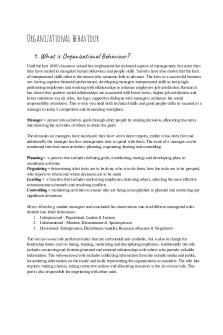
Organizational behaviour
- 67 Pages

Organizational Behaviour
- 2 Pages
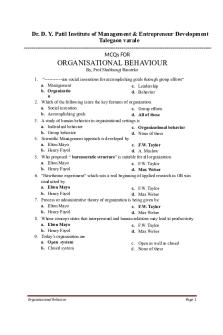
Organizational Behaviour mcqs
- 27 Pages
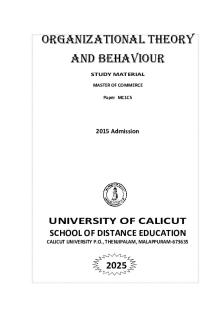
Organizational theory and behaviour
- 186 Pages
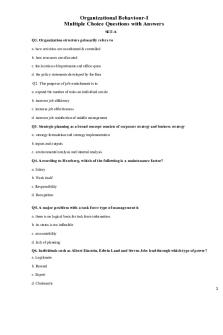
Organizational Behaviour MCQ SET
- 20 Pages
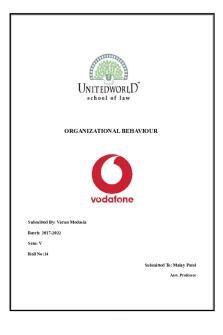
Organizational Behaviour Project
- 15 Pages

Chapter 2 ORGANIZATIONAL BEHAVIOUR
- 23 Pages
Popular Institutions
- Tinajero National High School - Annex
- Politeknik Caltex Riau
- Yokohama City University
- SGT University
- University of Al-Qadisiyah
- Divine Word College of Vigan
- Techniek College Rotterdam
- Universidade de Santiago
- Universiti Teknologi MARA Cawangan Johor Kampus Pasir Gudang
- Poltekkes Kemenkes Yogyakarta
- Baguio City National High School
- Colegio san marcos
- preparatoria uno
- Centro de Bachillerato Tecnológico Industrial y de Servicios No. 107
- Dalian Maritime University
- Quang Trung Secondary School
- Colegio Tecnológico en Informática
- Corporación Regional de Educación Superior
- Grupo CEDVA
- Dar Al Uloom University
- Centro de Estudios Preuniversitarios de la Universidad Nacional de Ingeniería
- 上智大学
- Aakash International School, Nuna Majara
- San Felipe Neri Catholic School
- Kang Chiao International School - New Taipei City
- Misamis Occidental National High School
- Institución Educativa Escuela Normal Juan Ladrilleros
- Kolehiyo ng Pantukan
- Batanes State College
- Instituto Continental
- Sekolah Menengah Kejuruan Kesehatan Kaltara (Tarakan)
- Colegio de La Inmaculada Concepcion - Cebu
